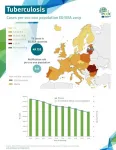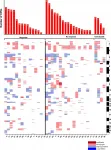Regional TB mortality has gone down, declining by 9.4% between 2018 and 2019. This is notably higher than the average global decline in TB mortality (3.7%) and enough to have reached the End TB Strategy milestone of a 35% reduction by 2020 compared to 2015.
However, TB is second only to COVID-19 as an infectious disease that kills, and drug resistance is a major concern. There are also worrying indications that the COVID-19 pandemic may stall progress or cause significant setbacks in the fight against TB.
The uneven burden of TB In 2019, there were an estimated 20 000 TB deaths in the WHO European Region - equivalent to 2.2 deaths per 100 000 people, and some 3560 TB deaths occurred in the European Union/European Economic Area (EU/EEA), equal to 0.7 deaths per 100 000. For 2019, in the European Region as a whole, there were some 216 000 new TB diagnoses, corresponding to 23.2 cases per 100 000.
Twenty-nine countries in the EU/EEA reported a total of 47 504 TB cases, which equates to a rate of 9.2 cases per 100 000. Across the EU/EEA, most country-specific rates continue to decline; however, the EU/EEA as a whole is currently not on track to reach the goal of ending TB by 2030.
TB is far from being evenly distributed in the European Region. Around 83% of estimated cases occur in 18 countries, where incidence is five times higher than the EU/EEA average. Five of the 18 high priority countries are within the EU/EEA, and 13 are in eastern Europe and central Asia.
COVID-19's impact on TB The decrease in TB burden put the Region on course to reach the End TB Strategy milestone for 2020 and the regional action plan target for reduction of the TB incidence rate. However, there are grave concerns that the COVID-19 pandemic may jeopardise recent progress.
Negative impacts have already been observed in TB service delivery and notifications in high-burden countries, this is believed to indicate that fewer people have been tested, meaning that people with undiagnosed TB are not getting the treatment they need and run the risk of infecting others.
The findings of an ongoing assessment of the impact of COVID-19 on TB services and spread in the European Region, will be ready in Spring 2021.
Treatment outcomes remain sub-optimal Despite universal access to quality-assured anti-TB drugs, treatment outcomes in the Region remain sub-optimal. Only 77% of patients successfully completed treatment in 2019, well below the global rate of 85%. Treatment success in the EU/EEA was lower still, with only 64% of all TB cases notified in 2018 being reported as having completed their treatment successfully.
Strains of TB that do not respond to commonly used treatment regimens are known as either multidrug-resistant tuberculosis (MDR-TB) or extensively drug-resistant tuberculosis (XDR-TB). Just 59% of MDR-TB cases notified in the Region in 2017 were successfully treated, far short of the 75% target. As for XDR-TB cases in 2016, treatment success was only 43%.
Across the Region, treatment outcomes for MDR-TB remain suboptimal. Unsuccessful treatment is one of the factors that drives resistance, often due to lack of effective TB medicines in treatment regimens for drug-resistant TB, and low adherence to therapy.
Overall, in the Region, every third pulmonary TB patient has a drug-resistant form of the disease. Across the Region, a quarter of drug-resistant TB patients have XDR-TB, and 70% of the world's XDR-TB patients live in the European Region.
The percentage of newly notified TB patients tested using WHO-recommended rapid diagnostic tests increased from 45% in 2015 to 69% in 2019, but nonetheless remains below the global End TB Strategy target of 90%. Rapid diagnostic tests allow quicker diagnosis, resulting in minimisation of suffering, onward transmission and death.
People living with HIV are particularly susceptible to TB, and coinfection is common. In the European Region, only 52% of coinfected patients complete TB treatment successfully, far below the global rate of 76%. This means that in the European Region there is a lower probability of people with a coinfection being successfully treated and making a full recovery.
TB at centre of health agendas Stella Kyriakides, European Commissioner for Health and Food Safety stated: "The decline of tuberculosis in recent years is positive news. But TB continues to be a threat to some regions in the EU and continues to affect the most vulnerable in our society. We know that there is still more work to do. Together with our agencies, the Commission is committed to playing its part to eliminate TB through, in part, funding, research and the fight against antimicrobial resistance. Prevention, early diagnosis and access to treatment and care will also play key roles in this regard".
ECDC Director Dr Andrea Ammon commented: "In the EU/EEA, the overall TB notification rate continued to fall in 2019, highlighting some progress towards the United Nations Sustainable Development Goals (SDGs). However, despite this progress, the EU/EEA is not currently on track to reach the goal of ending the TB epidemic by 2030. Further to this, across all cohorts, treatment success in the EU/EEA remains well below the WHO targets. The wide-scale disruption to TB services due to the COVID-19 pandemic will make it even more difficult for Member States to reach the SDGs and treatment targets, but now is the time for countries to accelerate their progress towards eliminating TB".
"How COVID-19 has drawn attention and resources away from TB services is of huge concern. I have no doubt that we'll get COVID-19 under control. But the price of that can never be losing hard won progress with other health threats, like TB. Today, the risk of drug-resistant TB becoming even more resistant is real, and it's not a risk we want to take. People need to realise this and understand the urgency of the action required and also know that we already have new opportunities and tools. Working towards ending TB is a crucial part of WHO's European Programme of Work and, having treated TB patients myself as a doctor, it is something that's very close to my heart. Great progress has been made in recent years, but challenges remain nonetheless. I therefore applaud the huge efforts made by countries in our region to overcome TB, a terrible and yet curable disease that causes great suffering," said Dr Hans Henri P. Kluge, WHO Regional Director for Europe.
INFORMATION:
Read the full report: https://www.ecdc.europa.eu/en/publications-data/tuberculosis-surveillance-and-monitoring-europe-2021-2019-data
Notes to editors:
The 18 high-priority countries are: Armenia, Azerbaijan, Belarus, Bulgaria, Estonia, Georgia, Kazakhstan, Kyrgyzstan, Latvia, Lithuania, the Republic of Moldova, Romania, the Russian Federation, Tajikistan, Turkey, Turkmenistan, Ukraine and Uzbekistan.
World Tuberculosis Day is observed on 24 March each year around the world. Its overall goal is to raise awareness concerning the burden of TB worldwide and the status of TB prevention and control efforts.
SDG target 3.3: By 2030, end the epidemics of AIDS, tuberculosis, malaria and neglected tropical diseases and combat hepatitis, water-borne diseases and other communicable diseases. The indicator is TB incidence per 100 000 population. The WHO End TB Strategy sub targets for measuring progress towards the SDGs are: TB incidence 80% lower in 2030 compared to 2015; the number of TB deaths 90% lower; and no family should face catastrophic costs due to TB.
The United Nations General Assembly high-level meeting on the fight against tuberculosis was held on 26 September 2018, resulting in a political declaration endorsed by Heads of State and Government outlining the key commitments that must be met for the world to end the TB epidemic by 2030, as called for in the SDGs.
The WHO European Region comprises 53 Member States with a population of over 900 million, of which around 517 million live in the EU/EEA (28 EU Member States plus Iceland, Liechtenstein, Norway and the United Kingdom in 2019).







